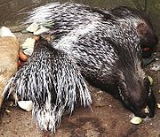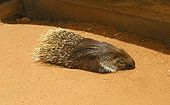
Indian Porcupine
Encyclopedia

Old World porcupine
The Old World porcupines, or Hystricidae, are large terrestrial rodents, distinguished by the spiny covering from which they take their name. They range over the south of Europe, most of Africa, India, and the Maritime Southeast Asia as far east as Borneo...
s. It is quite an adaptable rodent
Rodent
Rodentia is an order of mammals also known as rodents, characterised by two continuously growing incisors in the upper and lower jaws which must be kept short by gnawing....
, found throughout southern Asia
Asia
Asia is the world's largest and most populous continent, located primarily in the eastern and northern hemispheres. It covers 8.7% of the Earth's total surface area and with approximately 3.879 billion people, it hosts 60% of the world's current human population...
and the Middle East
Middle East
The Middle East is a region that encompasses Western Asia and Northern Africa. It is often used as a synonym for Near East, in opposition to Far East...
. It is tolerant of several different habitats: mountain
Mountain
Image:Himalaya_annotated.jpg|thumb|right|The Himalayan mountain range with Mount Everestrect 58 14 160 49 Chomo Lonzorect 200 28 335 52 Makalurect 378 24 566 45 Mount Everestrect 188 581 920 656 Tibetan Plateaurect 250 406 340 427 Rong River...
s, tropical and subtropical grassland
Grassland
Grasslands are areas where the vegetation is dominated by grasses and other herbaceous plants . However, sedge and rush families can also be found. Grasslands occur naturally on all continents except Antarctica...
s, scrublands, and forest
Forest
A forest, also referred to as a wood or the woods, is an area with a high density of trees. As with cities, depending where you are in the world, what is considered a forest may vary significantly in size and have various classification according to how and what of the forest is composed...
s. It is a large rodent, growing more than three feet long and weighing 32 pounds. It is covered in multiple layers of quills. The longest quills grow from its shoulders to about a third of the animal's length. Its tail is covered in short, hollow quills that can rattle when threatened. It has broad feet and long claws for digging. When attacked, the Indian Crested Porcupine raises its quills and rattles the hollow quills on its tail. If the predator persists past these threats, the porcupine launches a backwards assault, hoping to stab its attacker with its quills. It does this so effectively that most brushes between predators and the Indian porcupine end in death or severe injury.

Many conservationists, most notably Jim Corbett
Jim Corbett
James or Jim Corbett may refer to:*Jim Corbett , Edward James "Jim" Corbett , British-Indian hunter of man-eating tigers and leopards, conservationist, naturalist, photographer and author*James J...
and Kenneth Anderson
Kenneth Anderson (writer)
Kenneth Anderson was an Indian writer and hunter who wrote many books about his adventures in the jungles of South India.- Background :...
, have documented and noted that many tigers and leopards have become man-eaters after having fought and been injured by porcupines, which indicates their ferocity and their lack of predators. One such example was the Leopard of Gummalapur
Leopard of Gummalapur
The Leopard of Gummalapur, also known as the Spotted Devil of Gummalapur, was a man-eating Indian leopard responsible for the deaths of 42 people in the villages of Gummalapur and Devarabetta in southern Karnataka over an area of . At sundown, the villagers would barricade their doors, daring to...
, which when examined, was shown to have two porcupine quills lodged in its right forefoot.

